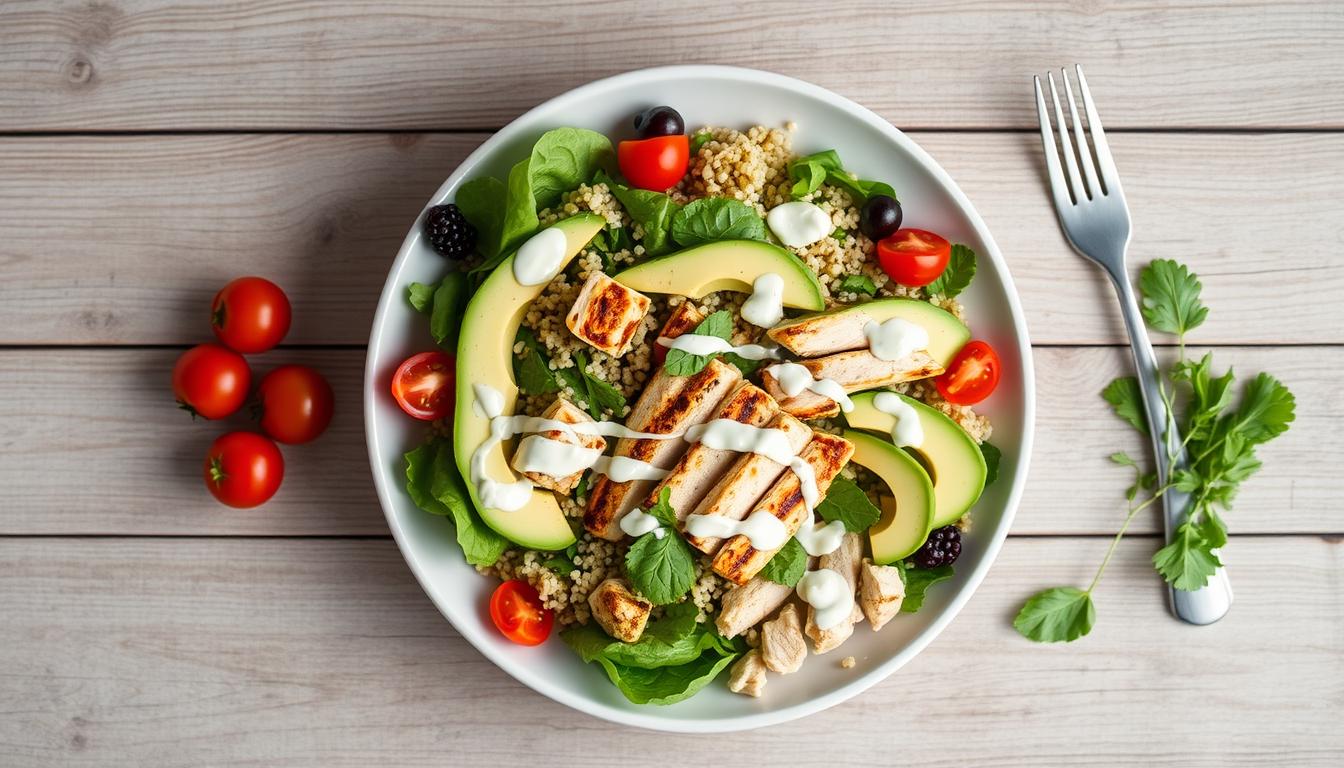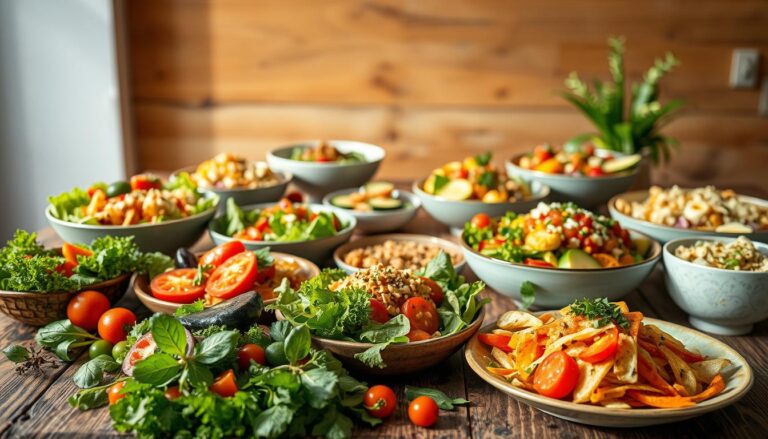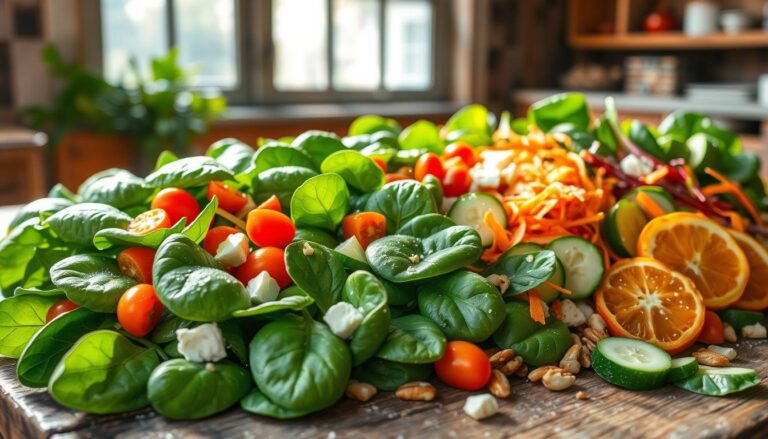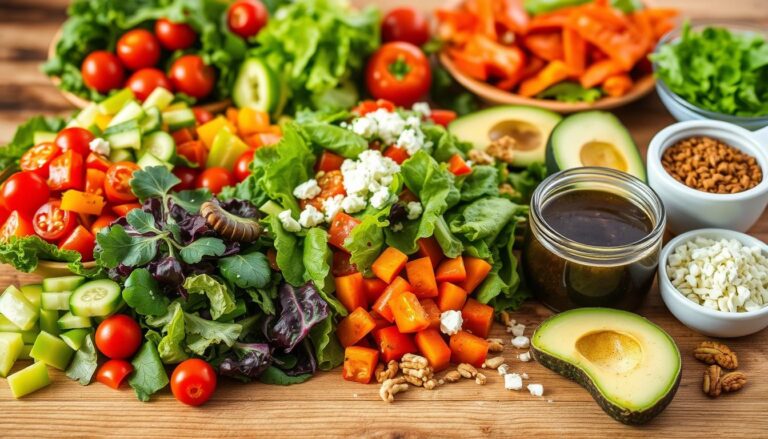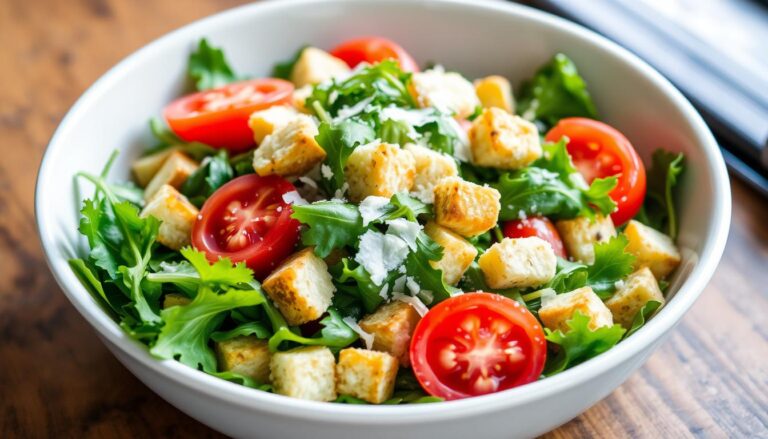The Ultimate High-Protein Salad Guide: 43+ Recipes For Every Diet

Table of Contents
Have you ever felt stuck in a nutrition rut, craving delicious and powerfully nutritious meals? Welcome to your comprehensive high-protein salad guide. It’s a game-changing approach to eating that turns ordinary salads into extraordinary wellness powerhouses.
Protein-packed salads aren’t just another diet trend. They’re a strategic way to fuel your body, boost metabolism, and satisfy hunger without compromising taste. Whether you’re an athlete, busy professional, or simply seeking healthier meal options, this guide offers protein-packed salads that fit seamlessly into your lifestyle.
Our carefully curated collection goes beyond typical salad recipes. We’ll explore versatile protein sources, innovative combinations, and meal strategies that make nutrition exciting. From plant-based alternatives to lean animal proteins, you’ll discover how to create high-protein salads that keep you energised and satisfied.
Prepare to revolutionise your eating habits with nutrient-dense, delicious salads that support your wellness goals. Your journey to smarter, more delightful nutrition starts here.
Understanding the Power of Protein-Packed Salads
Nutrient-dense salad recipes are more than just healthy meals. They are a smart way to eat that can change your diet and fitness goals. Protein-packed salads mix great taste, fullness, and health benefits. They help your body work at its best.
Your body needs balanced nutrition, and muscle-building salad bowls are a great choice. They mix fresh foods with high-quality proteins for the best nutrition.
Benefits of High-Protein Salads for Weight Management
Protein is key for managing weight by keeping you full longer. Adding nutrient-dense salad recipes to your diet brings many benefits:
- Increased metabolic rate
- Reduced hunger cravings
- Stabilised blood sugar levels
- Enhanced calorie burning
How Protein Supports Muscle Growth and Recovery
Muscle-building salad bowls are more than tasty. They are made to help your fitness goals. Protein gives your muscles the amino acids they need to heal and grow after hard workouts.
Optimal Protein Portions for Different Dietary Goals
Your protein needs change based on how active you are, your body type, and your fitness goals. Here’s a quick guide to adjust your protein intake:
- Weight Loss: 0.8-1.2 grams per pound of body weight
- Muscle Gain: 1.2-1.6 grams per pound of body weight
- Maintenance: 0.6-1 gram per pound of body weight
By knowing these tips, you can turn your salads into powerful tools for your health and fitness.
Essential Components of a High-Protein Salad
Making a high-protein salad means picking the right ingredients. Your salad should mix protein sources, fresh greens, and add-ins for great taste and nutrition.
Here’s what you need for a protein-rich meal:
- Protein Foundation: Use lean meats like grilled chicken, turkey, or fish to add protein
- Leafy Green Base: Spinach, kale, or mixed greens add important nutrients
- Healthy Fats: Add avocado, nuts, or olive oil for lasting energy
- Fibre-Rich Additions: Quinoa, beans, or seeds help with digestion
Start your high-protein salad guide by choosing quality ingredients. You can pick from animal or plant-based proteins, fitting different diets.
Try these protein-rich salad ideas:
- Grilled salmon + mixed greens + chia seeds
- Roasted chicken + arugula + almonds
- Tofu + spinach + pumpkin seeds
Knowing these key components helps you make tasty, healthy meals. These meals support your health and fitness goals.
Tools and Equipment for Salad Making
| Appliance/Tool | Brand | Description | Example Amazon Affiliate Product (US) |
|---|---|---|---|
| Mandoline Slicer | OXO | For ultra-thin, uniform cucumber slices (key for texture in Asian salads). | OXO Mandoline Slicer |
| Food Processor | Cuisinart | Quickly chops cucumbers, onions, or blends dressings. | Cuisinart Food Processor |
| Immersion Blender | KitchenAid | Blends dressings directly in bowls (e.g., sesame-garlic vinaigrette). | KitchenAid Immersion Blender |
| Digital Kitchen Scale | Escali | Precise measurements for dressing ingredients (sugar, vinegar, etc.). | Escali Digital Scale |
| Electric Spiralizer | Paderno | Creates fun cucumber ribbons/noodles for presentation. | Paderno Spiralizer |
| Vacuum Sealer | NutriChef | Extends salad freshness for meal prep (if storing dressed cucumbers). | NutriChef Vacuum Sealer |
| Handheld Torch | Sondiko | Lightly char toppings (e.g., sesame seeds or chili flakes) for enhanced aroma. | Sondiko Kitchen Torch |
Plant-Based Protein Sources for Salads
Creating delicious high-protein vegetarian salads starts with understanding the powerful plant-based protein sources available. These nutrient-dense ingredients can transform an ordinary salad into a protein-packed meal that satisfies and nourishes your body.
Plant-based protein salads offer incredible versatility and nutrition. By incorporating the right ingredients, you can easily meet your protein requirements while enjoying a delicious and healthy meal.
Legumes and Pulses: Protein Powerhouses
Legumes and pulses are exceptional protein sources for vegetarian salads. These ingredients pack a serious nutritional punch:
- Chickpeas: 14.5 grams of protein per cup
- Black beans: 15.2 grams of protein per cup
- Lentils: 17.9 grams of protein per cup
- Edamame: 18.4 grams of protein per cup
Nuts and Seeds: Crunchy Protein Additions
Enhance your high-protein vegetarian salads with these nutrient-dense nuts and seeds:
| Nut/Seed | Protein per 1/4 Cup |
|---|---|
| Almonds | 7 grams |
| Pumpkin Seeds | 9 grams |
| Walnuts | 5 grams |
| Chia Seeds | 6 grams |
Plant-Based Protein Alternatives
Beyond legumes and nuts, explore these innovative protein alternatives for your salads:
- Tofu: Firm tofu can be grilled or baked for a protein-rich salad topper
- Tempeh: Fermented soybean cake with a nutty flavor
- Seitan: Wheat-based protein with a meat-like texture
By strategically combining these plant-based protein sources, you can create satisfying and nutritious salads that support your dietary goals.
Animal Protein Options for Nutrient-Dense Salads
Adding high-quality animal proteins to your salad makes it a nutritional powerhouse. Lean meat salad toppers are great for boosting protein without making your meal heavy.
Your choice of protein greatly affects your salad’s nutrition and taste. Here are some top animal protein options to make your salad delicious and nutritious:
- Chicken breast: A classic lean protein with versatile seasoning options
- Turkey: Low-fat alternative with rich, mild flavor
- Salmon: Packed with omega-3 fatty acids
- Shrimp: Quick-cooking seafood salad variety with low calorie count
- Lean beef: Provides robust flavor and essential nutrients
Seafood salad varieties add unique nutritional benefits. Fish like tuna and salmon are full of heart-healthy omega-3s. Shellfish offer zinc and selenium. Choose about 4-6 ounces of protein per serving for balanced nutrition.
| Protein Source | Calories per 4 oz | Protein (g) | Key Nutrients |
|---|---|---|---|
| Grilled Chicken Breast | 120 | 26 | Vitamin B6, Selenium |
| Salmon | 233 | 25 | Omega-3, Vitamin D |
| Shrimp | 120 | 23 | Selenium, Vitamin B12 |
Pro tip: Choose grilling, baking, or poaching for lean proteins. Marinating adds flavor without extra calories. This makes your salad both healthy and tasty.
High-Protein Salad Guide: Building Your Perfect Bowl
Making a nutrient-dense salad needs careful planning and the right ingredients. Start by learning how to make a balanced, tasty meal. This meal should meet your nutritional and taste needs.
To make the perfect high-protein salad, you need to plan well. Your goal is to mix great taste, nutrition, and satisfaction in one meal.
Base Greens Selection
Picking the right base for your salad is key. Here are some top greens to choose from:
- Spinach: Rich in iron and nutrients
- Kale: Dense in vitamins and minerals
- Arugula: Peppery flavor with low calories
- Mixed spring greens: Variety of textures and tastes
Protein Pairing Strategies
Protein is essential for a filling salad. Mix different protein sources to go well with your greens:
- Grilled chicken breast
- Baked tofu cubes
- Hard-boiled eggs
- Canned salmon or tuna
- Roasted chickpeas
Dressing and Seasoning Tips
Your salad guide wouldn’t be complete without talking about flavor. Pick dressings that add flavor without being too much:
- Vinaigrettes: Light and tangy
- Greek yogurt-based: Creamy and protein-rich
- Herb-infused olive oil: Fresh and aromatic
Pro tip: Always prepare dressings separately to maintain salad freshness and prevent soggy greens.
Try these tips to make many different protein-rich salads. This will keep your meals interesting and full of nutrients.
Low-Carb High-Protein Salad Combinations
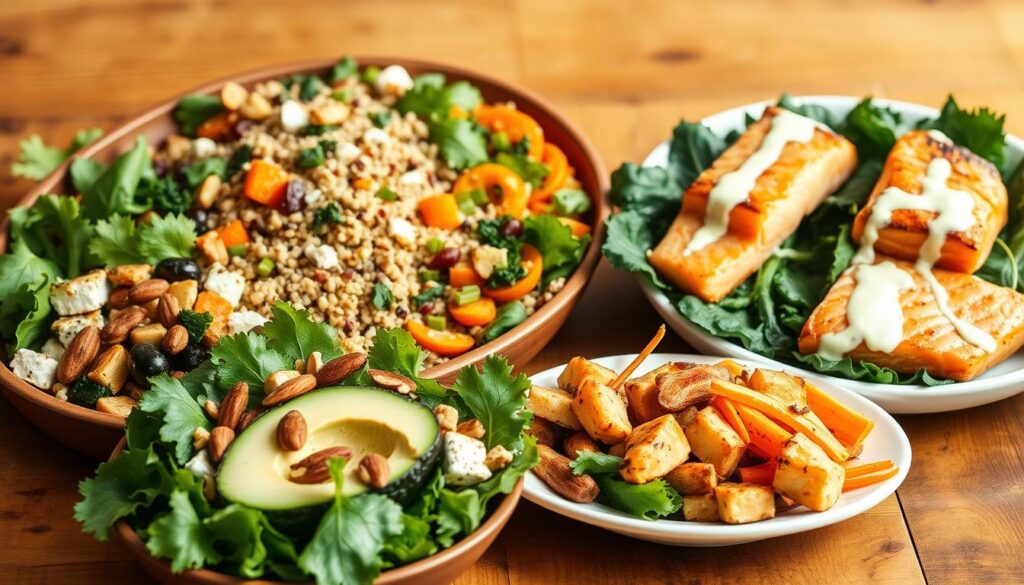
Creating low-carb salad options that are high in protein can change how you plan meals. These mixes are full of nutrients and taste great. They help you eat healthy while keeping carbs low.
Start your low-carb protein salad with the right base. Choose leafy greens like spinach, arugula, or mixed spring greens. They have few carbs but are packed with nutrients.
- Spinach and Grilled Chicken Salad
- Keto-Friendly Salmon and Avocado Bowl
- Egg and Bacon Mixed Green Salad
- Tuna and Cucumber Mediterranean Style
For a protein-packed salad, add the right toppings. Think about adding:
- Grilled chicken breast
- Hard-boiled eggs
- Canned tuna
- Salmon
- Shredded cheese
Choose dressings that fit your low-carb diet. Olive oil-based dressings, ranch with full-fat ingredients, and vinaigrettes without added sugars are great choices.
Pro tip: Always measure your protein portions to ensure you’re getting enough nutrients without excess calories.
Your low-carb salad mixes can be both filling and healthy. By picking the right ingredients, you make meals that meet your diet goals. Plus, they keep your taste buds happy.
Meal Prep Strategies for Protein-Rich Salads
Preparing high-protein salads ahead of time can change your nutrition and fitness goals. A good high-protein salad guide keeps you on track with your diet. It also makes sure you have tasty salad fuel after workouts.
Meal prep changes how you eat healthy. Spend a few hours each week planning and prepping. This way, you make salads that help your fitness and wellness.
Storage Solutions for Maximum Freshness
Keeping your protein-packed ingredients fresh is key for taste and nutrition. Here are some tips to keep your salad fresh:
- Store leafy greens in airtight containers with paper towels to absorb moisture
- Keep protein sources like grilled chicken or tofu in separate sealed containers
- Separate wet and dry ingredients until ready to eat
- Use glass containers for better preservation
Make-Ahead Components
Not all salad ingredients need last-minute prep. Some can be prepped days ahead:
- Cooked proteins (chicken, eggs, beans)
- Chopped vegetables
- Roasted nuts and seeds
- Homemade dressings
Weekly Prep Schedule
Having a plan ensures you always have salad fuel ready. Here’s a weekly prep plan:
| Day | Prep Task | Time Required |
|---|---|---|
| Sunday | Batch cook proteins | 60 minutes |
| Monday | Chop vegetables | 30 minutes |
| Wednesday | Prepare dressings | 15 minutes |
| Friday | Refresh ingredients | 20 minutes |
By spending a bit of time upfront, you’ll have a system for enjoying healthy, protein-rich salads all week.
Creative Protein Toppers and Crunchy Elements
Make your protein-packed salads stand out with creative crunchy elements. These add-ons boost nutrition and flavor. They turn your salads into tasty, healthy dishes that excite your taste buds.
Here are some protein-rich crunchy additions to try:
- Roasted Chickpea Croutons: Crispy, seasoned chickpeas add protein and crunch
- Spiced Seed Blends: Pumpkin, sunflower, and hemp seeds for extra nutrition
- Homemade Nut Clusters: Almonds, walnuts, and pecans toasted with herbs
- Crispy Quinoa Sprinkles: Toasted quinoa adds texture and protein
Making these toppers is easy and can be done ahead of time. Cook them in bulk on the weekend. Store them in airtight containers for quick additions to your salads all week. The fun part is trying new spices and cooking methods to keep your salads fresh and tasty.
Pro tip: Change up your toppers to avoid getting bored. Mix roasted chickpeas with seed blends for a mix of textures. This keeps your salads interesting and full of nutrients.
Seasonal Salad Variations for Year-Round Enjoyment
Creating a high-protein salad guide means adapting your recipes to the seasons. You can keep your meals exciting and healthy all year. Just pick ingredients that match each season’s produce and weather.
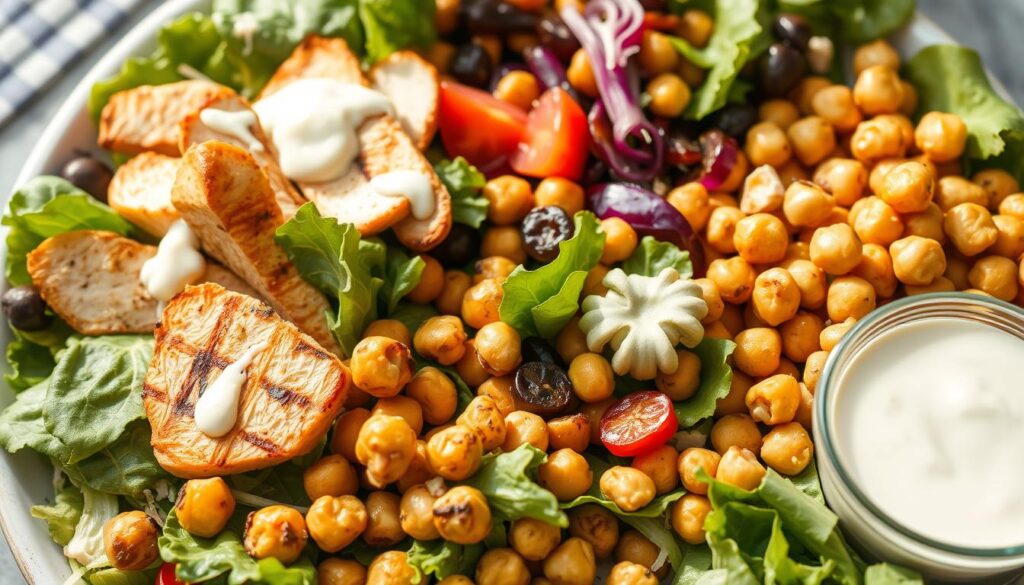
Exploring seasonal salads lets you enjoy great flavors and nutrition. It also makes your meals diverse and interesting.
Spring and Summer Options
Warm months are perfect for light, refreshing salads. These salads are full of energy and hydration. Try these lively options:
- Strawberry quinoa salad with grilled chicken
- Watermelon feta salad with mint and grilled shrimp
- Citrus-marinated salmon with mixed greens
Fall and Winter Combinations
Cooler seasons need heartier, warming salads. These salads offer great nutrition and comfort:
- Roasted butternut squash with pecans and turkey
- Warm lentil salad with roasted root vegetables
- Kale and Brussels sprout salad with grilled steak
| Season | Protein Source | Key Ingredients |
|---|---|---|
| Spring | Grilled Chicken | Asparagus, radishes, fresh herbs |
| Summer | Shrimp | Corn, cherry tomatoes, cucumber |
| Fall | Turkey | Roasted squash, pecans, cranberries |
| Winter | Beef | Roasted root vegetables, kale |
By changing your protein sources and using seasonal produce, you’ll have a dynamic salad guide. Your meals will stay nutritious and enjoyable all year.
Dressings and Marinades for Protein Enhancement
Make your protein-packed salads better with special dressings and marinades. These can turn simple meals into powerful nutrition boosters. Your post-workout salad needs more than just basic toppings. It needs flavors and proteins that help with muscle recovery and taste great.
It’s easy to make dressings that add protein to your salads. Just a few simple ingredients can make a big difference:
- Greek yogurt-based dressings
- Nut butter vinaigrettes
- Protein powder-infused marinades
- Cottage cheese cream dressings
Here are some secret salad ingredients that help build muscle:
- Protein Smoothie Dressing: Blend vanilla protein powder, almond milk, and a bit of honey for a creamy topping
- Tahini Protein Vinaigrette: Mix tahini, lemon juice, and whey protein for a Mediterranean-inspired drizzle
- Peanut Butter Power Marinade: Combine natural peanut butter, soy sauce, and protein isolate for grilled chicken or tofu
When you add dressings to your post-workout salad, they do more than just taste good. They also help meet your nutritional needs. Try different proteins and flavors to keep your meals interesting and focused on muscle building.
Dietary Considerations and Adaptations
Making high-protein vegetarian salads needs careful planning. You can meet many dietary needs without losing flavor or protein.
Every diet has its own needs. Whether you’re on a keto, vegan, or gluten-free diet, you can make protein-packed salads fit your goals.
Keto-Friendly Modifications
Low-carb salads are great for keto diets. Use these protein-rich foods:
- Grilled chicken or fish
- Hard-boiled eggs
- Avocado chunks
- Cheese crumbles
- Nuts and seeds
Vegan and Vegetarian Options
Vegetarian salads can be very fulfilling. Mix plant-based proteins for full nutrition:
| Protein Source | Protein Content | Recommended Serving |
|---|---|---|
| Tofu | 8g per 1/2 cup | Grilled or marinated |
| Quinoa | 8g per cup | Chilled and seasoned |
| Chickpeas | 7g per 1/2 cup | Roasted or fresh |
Gluten-Free Alternatives
Choose certified gluten-free ingredients to avoid cross-contamination. Always read labels and pick whole food proteins for a safe and healthy salad.
- Rice-based proteins
- Legume alternatives
- Organic seed mixes
Being flexible is crucial for adapting salads to different diets. With a bit of creativity and knowledge, you can make tasty, protein-rich meals that help you stay healthy.
Conclusion
Diving into high-protein salad recipes opens a world of nutrition for your diet. This guide shows that healthy salads are exciting and support your health goals.
You’ve learned about plant-based and lean animal proteins. These can turn simple salads into powerful meals. With over 43 recipes, you can find something for every need.
Your kitchen is ready for meal prep, seasonal changes, and new protein mixes. You’ve got more than recipes; you have a way to eat that’s both tasty and healthy. Start making your salads that match your health journey.
The best diet is one you love and can keep up with. These salads are more than food; they’re a way to feel good and meet your nutritional needs. Your next protein-packed salad is waiting for you!
FAQ
How much protein should I aim for in a salad?
Can vegetarians and vegans get enough protein in their salads?
How can I make my salads more filling and satisfying?
Are high-protein salads good for weight loss?
How long can I prep high-protein salads in advance?
What are the best low-carb protein sources for salads?
Can I make high-protein salads without meat?
How do I keep my high-protein salads interesting and flavorful?
How did you find this recipe?
There are no reviews yet. Be the first one to write one.

